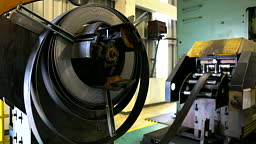Would You Like To Know What Metal Stamping Is?

Metal stamping refers to the process of shaping and cutting metal alloys into specific forms, which will then be used as components for large machinery and structures. Such as products like cans and pans, sheets of metal can be molded into different shapes that people use. The most common of the metals that are used when metal stamping are aluminum, titanium, steel and zinc. Metal stamping is popular because it is a very cost effective and productive way to produce many kinds of metal products on a very large scale.
When metal stamping, the metal sheets are put into a die or press tool that has a specially designed cavity, which will give the desired shape to the metal sheet. The upper part of the die is going to connect to the press slide, while the lower component will connect to the press bed. To perform the actual shaping operation, a specific component called the punch will push the metal sheet through the press tool. It will be coated with gold, palladium, nickel or tin to prevent any corrosion after the sheet of metal has been pressed and shaped.
Making sure the piece of metal is plated will also increase the toughness and longevity of the product. Sometimes, the plating is done before the metal sheet has been pressed and shaped and the product is cleaned to remove any excess metal stamping oils and films. The product will then be heat treated to make it stronger, since it is still soft after the stamping process. After all of this has been done, the product is still going to have very sharp corners, so it must undergo a process called the deburring process. The deburring process is typically done with the help of strong chemicals and abrasives. Other than these steps, iso 9001 metal stamping may also involve other metalworking processes such as piercing, blanking, drawing or forming on the same machines.
A very specific force, speed and precision is what stamping presses will have for giving shape to the metal. Mechanical and hydraulic are the two kinds of metal stamping presses and they are available in an extensive range of capacities, sizes, stroke lengths and operating speeds.
Metal forming processes like forging, die casting, fabricating and machining have been slowly replaced over the years by metal stamping. Find out more about this in CAR Engineering & Manufacturing. Because metal stamping is much more cost efficient than anything else, this is one of the biggest reasons. The dies that are most commonly used in metal stamping cost much less than the ones that are used in processes like forging and casting.